Illustrator and live-drawer Tara Black had a Skype date with Chris Riddell in advance of his appearance in New Zealand for the Auckland Writers’ Festival. They discussed his time as the British children’s laureate, his political cartooning, his inspiration for characters, working with Neil Gaiman, and much much more. Here is their drawn conversation – with extra drawings from the man himself.
Full transcript below article, for sight-impaired readers.
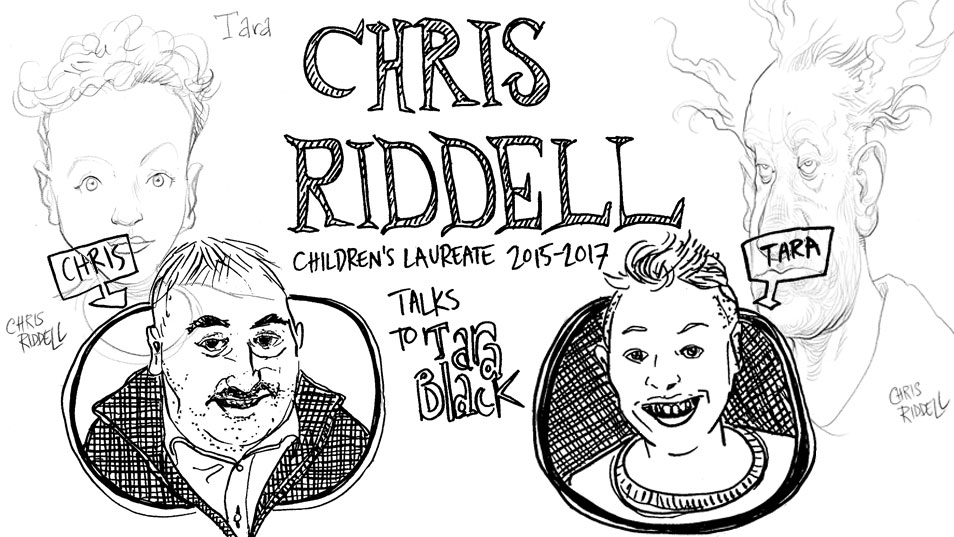
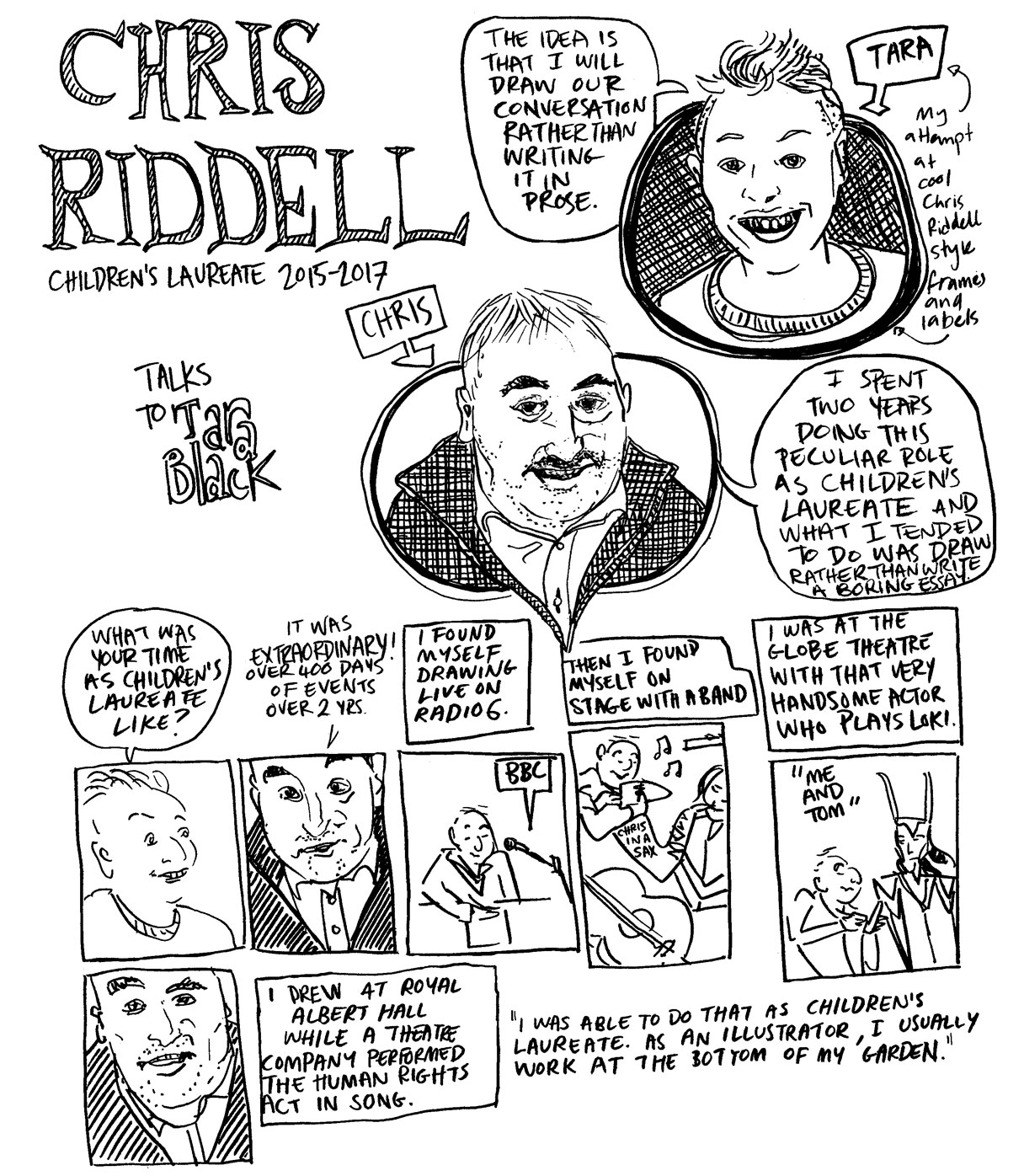
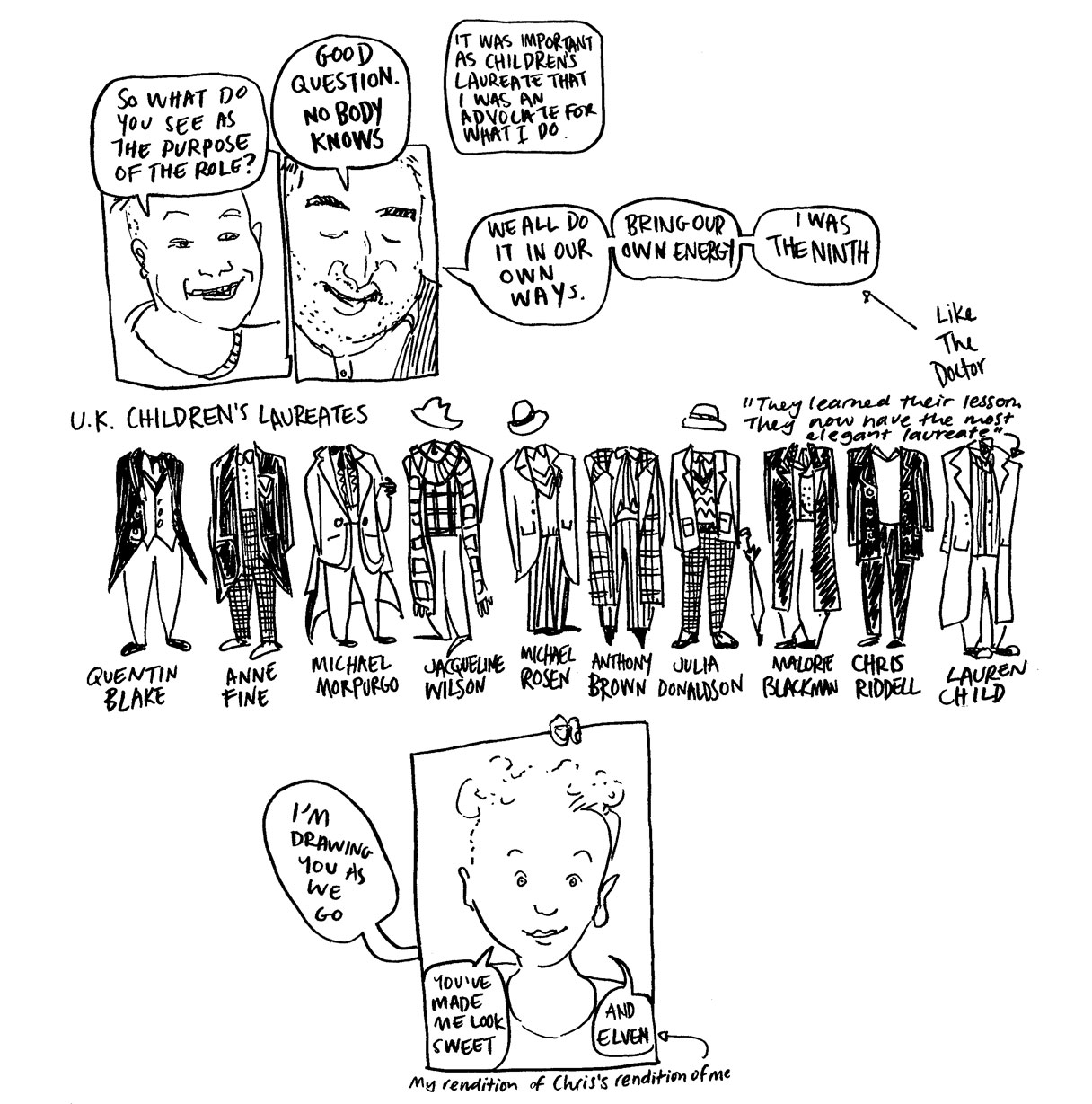
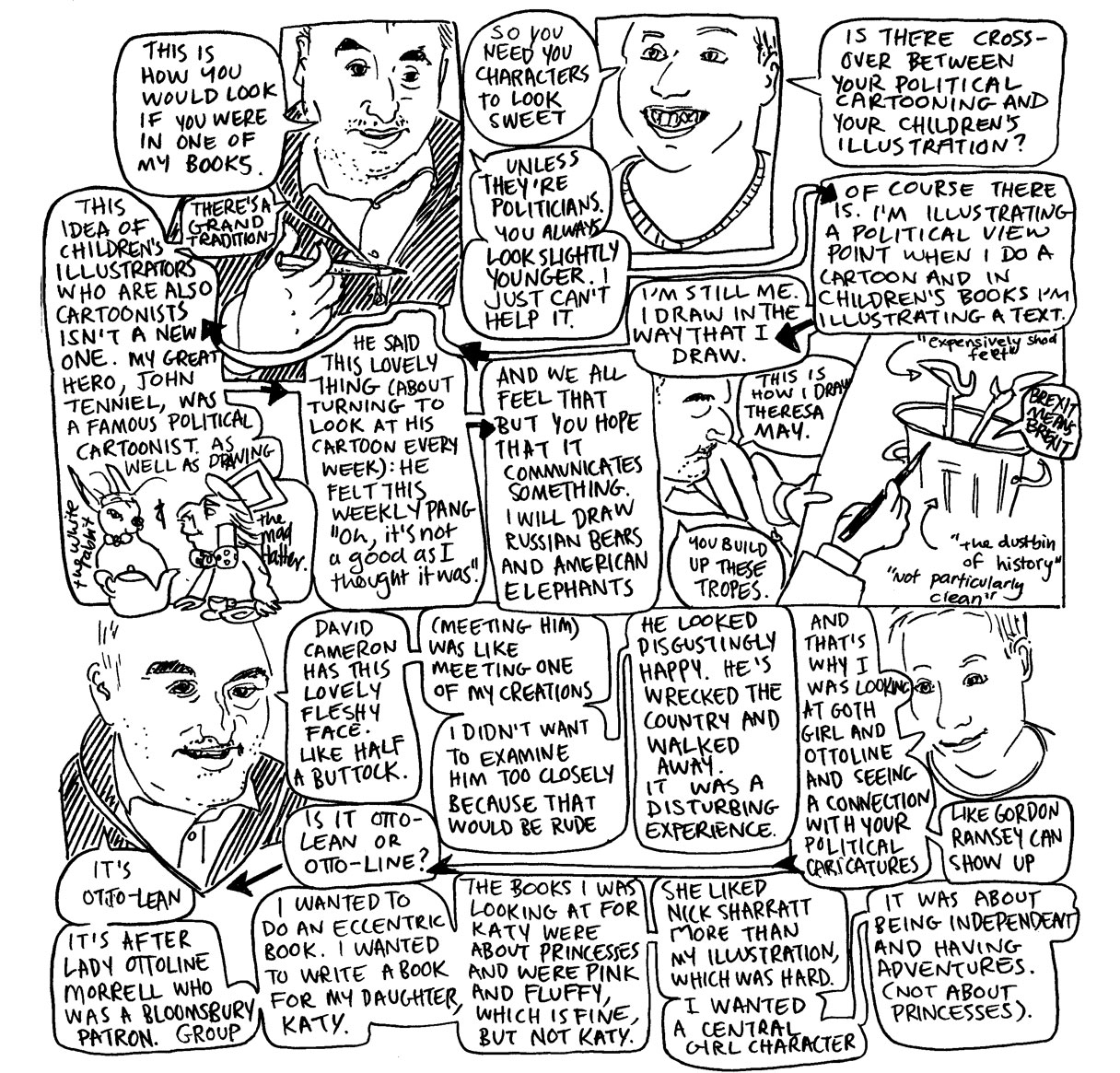
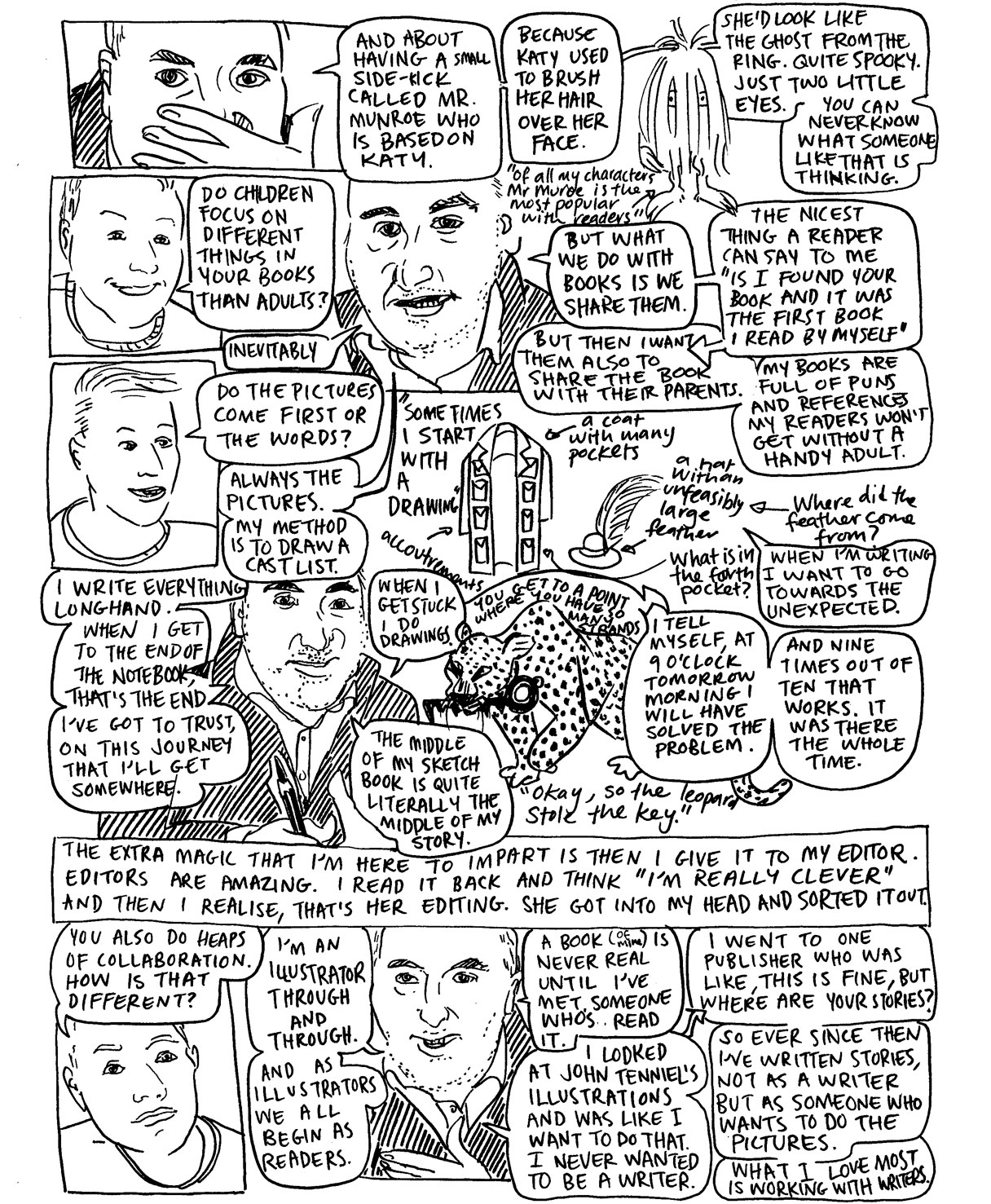
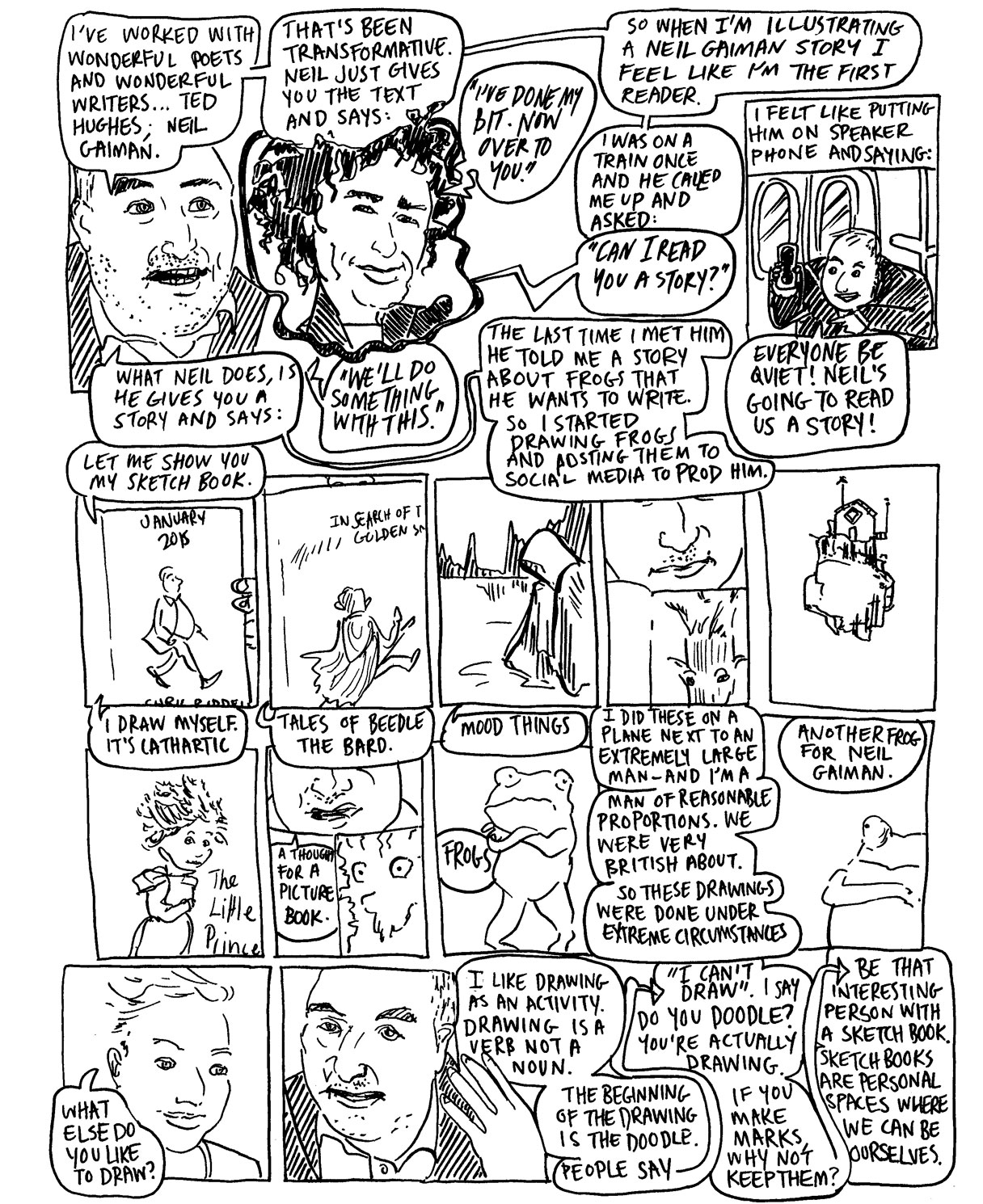
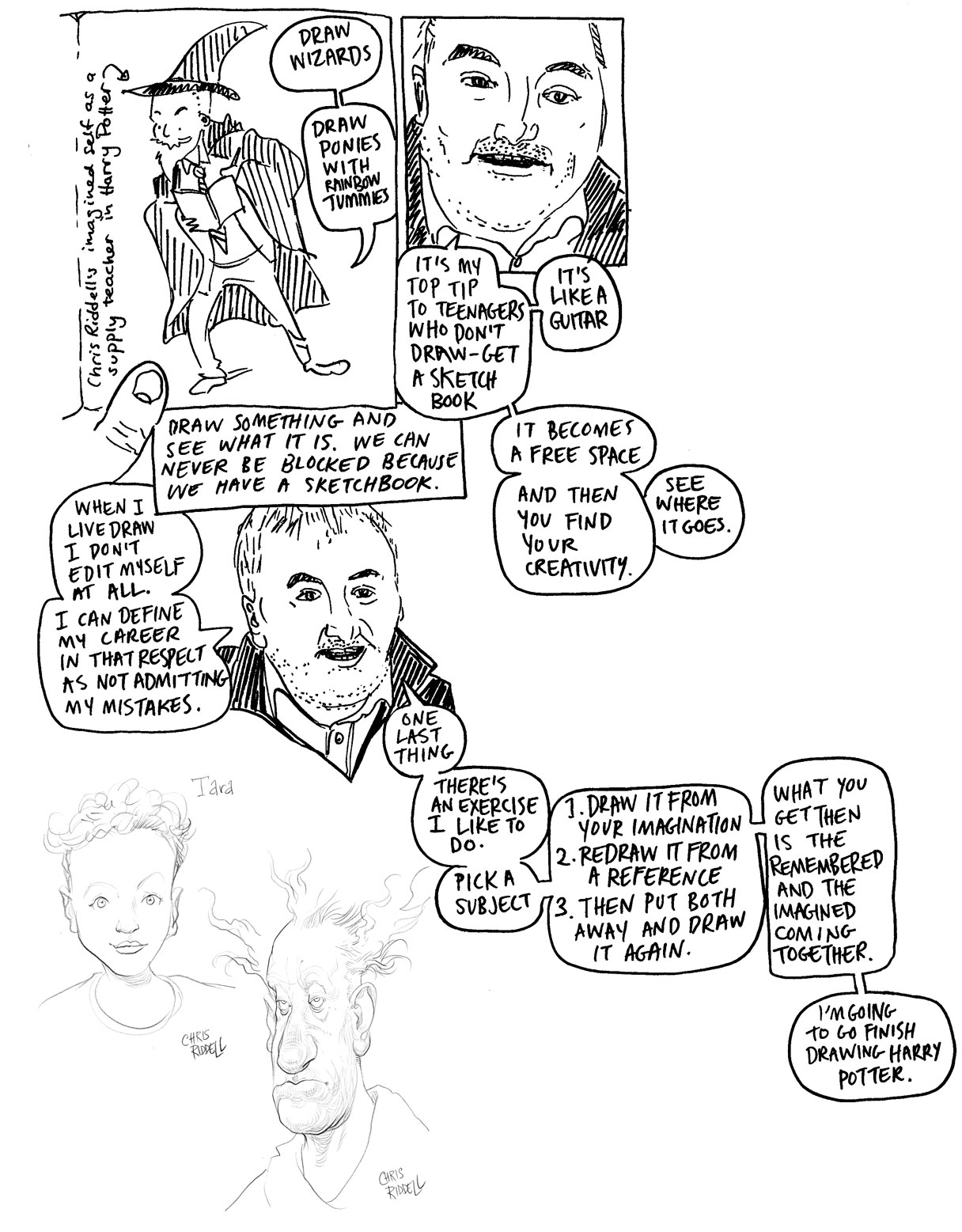
Chris Riddell Children’s Laureate 2015 – 2017 talks to Tara Black (in comic strips)
This transcript indicates who the image is of in brackets, followed by the speech bubbles attached, left to right, down the screen.
(image Tara) The idea is that I will draw our conversation rather than writing it in prose.
arrows point to frames My attempt at cool Chris Riddell style frames and labels
(image Chris) I spent two years doing this peculiar role as Children’s Laureate and what I tended to do was draw rather than write a boring essay.
(image Tara) What was your time as Children’s Laureate like?
(image Chris) It was extraordinary! Over 400 days of events over 2 years.
(Chris at BBC) I found myself drawing live on Radio 6
(Chris with band) Then I found myself on stage with a band
(Chris with Loki) I was at the Globe Theatre with that very handsome actor who plays Loki (Tom Hiddleston)
(Chris) I drew at Royal Albert Hall while a theatre company performed the Human Rights Act in song.
“I was able to do that as Children’s Laureate. As an illustrator, I usually work at the bottom of my garden.”
(image Tara) So what do you see as the purpose of the role?
(image Chris) Good question. Nobody knows.
(box text) It was important as Children’s Laureate that I was an advocate for what I do.
(Chris speaking) We all do it in our own ways, bring our own energy, I was the Ninth (arrow to “Ninth” – like the Doctor)
(Image of UK children’s laureates denoted by the clothes of the first nine Doctor Whos)
(text) Quentin Blake, Anne Fine, Michael Morpurgo, Jacqueline Wilson, Michael Rosen, Anthony Brown, Julia Donaldson, Malorie Blackman, Chris Riddell, Lauren Child
(arrow to Lauren Child) “They learned their lesson. They now have the most elegant laureate.”
(Tara’s rendition of Chris’ rendition of her) Speech from Chris – I’m drawing you as we go. Speech from Tara – You’ve made me look sweet. And elven.
(Image Chris) This is how you would look if you were in one of my books.
(image Tara) So you need your characters to look sweet
(speech Chris) Unless they’re politicians. You always look slightly younger. I just can’t help it.(speech Tara) Is there cross over between your political cartooning and your Children’s illustration?(speech Chris) Of course there is. I’m illustrating a political view point when I do a cartoon and in children’s books I’m illustrating a text.
I’m still me. I draw in the way that I draw.
This idea of children’s illustrators who are also cartoonists isn’t a new one. My great hero, John Tenniel, was a famous political cartoonist. As well as drawing The White Rabbit and The Mad Hatter (illustrations of both.)
He said this lovely thing (about turning to look at his cartoon every week): He felt this weekly pang “oh, it’s not as good I thought it was.”
And we all feel that but you hope that it communicates something. I will draw Russian bears and American elephants.
(speech Chris) You build up these tropes. This is how I draw Theresa May.
(illustration of Theresa May with expensively shod feet upside down in a bin, labelled ‘The dustbin of history’ ‘not particularly clean.’)
(image Chris) David Cameron has this lovely fleshy face. Like half a buttock. (Meeting him) was like meeting one of my creations. I didn’t want to examine him too closely because that would be rude.
He looked disgustingly happy. He’s wrecked the country and walked away. It was a disturbing experience.
(Image Tara) And that’s why I was looking at Goth Girl and Ottoline and seeing a connection with your political caricatures. Like Gordon Ramsay can show up. Is it Otto-lean or Otto-line?
(speech Chris) It’s Otto-lean. It’s after Lady Ottoline Morrell who was a Bloomsbury Group Patron.
I wanted to do an eccentric book. I wanted to write a book for my daughter, Katy. The books I was looking at for Katy were about princesses and were pink and fluffy, which is fine, but not Katy.
She liked Nick Sharratt more than my illustration, which was hard. I wanted a central girl character. It was about being independent and having adventures – Not about princesses.
(image Chris) And about having a small side-kick called Mr Munroe who is based on Katy. Because Katy used ot brush her hair over her face. (image of hairy character) She’d look like the ghost from The Ring. Quite spooky. Just two little eyes. You can never know what someone like that is thinking.
(floating) “of all my characters, Mr Munroe is the most popular with readers.”
(image Tara) Do children focus on different things in your books than adults?
(Image Chris) Inevitably.
But what we do with books is we share them. The nicest thing a reader can say to me is “I found your book and it was the first book I read by myself.”
But then I want them also to share the book with their parents.
My books are full of puns and references my readers won’t get without a handy adult.
(Image Tara) Do the pictures come first or the words?
(speech Chris) Always the pictures. My method is to draw a cast list. Sometimes I start with a drawing. Series of images here: A coat with many pockets. A hat with an unfeasibly large feather. (where did the feather come from?) (What is in the fourth pocket?) When I’m writing I want to go towards the unexpected.
(image Chris) I write everything longhand. When I get to the end of the notebook, that’s the end. I’ve got to trust, on this journey that I’ll get somewhere.
The middle of my sketch book is quite literally the middle of my story.
When I get stuck I do drawings.
You get to a point where you have so many strands. I tell myself, at 9’o’clock tomorrow morning I will have solved the problem. And nine times out of ten that works. It was there the whole time.
(image leopard with a key in its mouth) – “Okay, so the leopard stole the key.”
(box Chris) The extra magic that I’m here to impart is then I give it to my Editor. Editors are amazing. I read it back and think “I’m really clever” and then I realise, that’s her editing. She got into my head and sorted it out.
(image Tara) You also do heaps of collaboration. How is that different?
(image Chris) I’m an illustrator through and through. And as illustrators we all begin as readers.
A book (of mine) is never real until I’ve met someone who’s read it.
I looked at John Tenniel’s illustrations and was like, I want to do that. I never wanted to be a writer.
I went to one publisher who was like, this is fine, but where are your stories?
So ever since then, I’ve written stories, not as a writer, but as someone who wants to do the pictures. What I love most is working with writers.
(image Chris) I’ve worked with wonderful poets and wonderful writers … Ted Hughes; Neil Gaiman. That’s been transformative. Neil just gives you the text and says. (illustration of Neil Gaiman) “I’ve done my bit – Now over to you.” So when I’m illustrating a Neil Gaiman story I feel like I’m the first reader.
I was on a train once and he called me up and asked. “Can I read you a story?”
(image Chris on train) I felt like putting him on speaker phone and saying: Everyone be quiet! Neil’s going to read us a story!
(speech Chris) What Neil does, is he gives you a story and says “We’ll do something with this.”
The last time I met him he told me a story about frogs that he wants to write. So I started drawing frogs and posting them to social media to prod him.
Let me show you my sketch book. Images: (man walking) I draw myself, It’s cathartic, (in search of golden snitch) Tales of Beedle the Bard, (cloaked person in desert) Mood things, (face, tree with eyes, howls moving castle.)
(More images: The little prince. A thought for a picture book. Frogs.)
(speech Chris) I did these on a plane next to an extremely large man – and I’m a man of reasonable proportions. We were very British about it. So these drawings were done under extreme circumstances.
(Image Frog, captioned Another frog for Neil Gaiman.)
(Image Tara) What else do you like to draw?
(Image Chris) I like drawing as an activity. Drawing is a verb not a noun. The beginning of the drawing is the doodle. People say “I can’t draw”. I say do you doodle? You’re actually drawing.
If you make marks, why not keep them? Be that interesting person with a sketch book. Sketch books are personal spaces where we can be ourselves.
(Image of a wizard captioned Chris Riddell’s imagined self as a supply teacher in Harry Potter.)
(speech Chris) Draw wizards. Draw ponies with rainbow tummies.
(image Chris) It’s my top tip to teenagers who don’t draw – get a sketch book – it’s like a guitar. It becomes a free space and then you find your creativity. See where it goes.
(speech box Chris) Draw something and see what it is. We can never be blocked because we have a sketchbook.
(image Chris) When I live draw I don’t edit myself at all. I can define my career in that respect as not admitting my mistakes.
One last thing. There’s an exercise I like to do.
Pick a subject.
1. Draw it from your imagination
2. Redraw it from a reference
3. Then put both away and draw it again
What you get then is the remembered and the imagined coming together.
I’m going to go finish drawing Harry Potter.
(images at bottom drawn by Chris Riddell, depicting Tara Black and Chris Riddell.)
Chris Riddell is brought to the Auckland Writers Festival with the support of Platinum Bold Patron Adrian Burr. He is appearing throughout the schools programme, and in one public event on Wednesday 15 May: The Sketcher: Chris Riddell. Go and see him!

Tara Black
Tara Black can often be found in the front row of book events, illustrating authors and their ideas. She has an MCW from Massey University and loves fried potato. Her first graphic novel, This Is Not a Pipe, is out now from VUP. Image: Ebony Lamb



